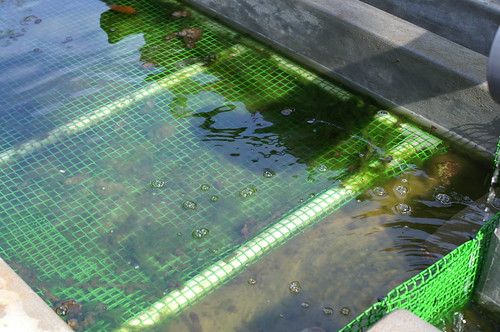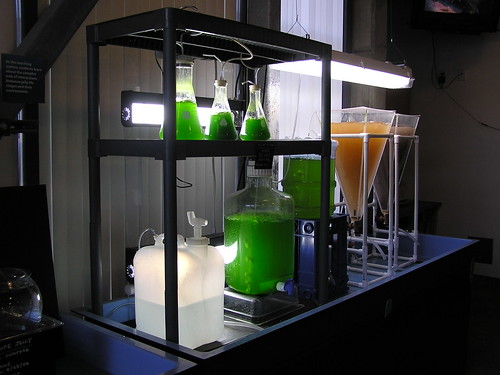The news of algae as a potential source for bio-fuels broke in 2006 and then again earlier this year. As the cost prohibitive and resource draining processes of coal-to-liquid fuel and corn-to-ethanol have reached long discussions on the national bureaucratic scene, algae-to-fuel has received its push toward market efficacy in the private sector. A lot of time has been spent on this site discussing alternative fuels, hybrids and other forums of fuel efficiency and restrained pollutants. It doesn’t seem likely that the topic will end here, either.

Two small corporations are spearheading the push for this fuel source: Solix out of Ft. Collins, Colorado and GreenFuel Technologies Corporation out of Cambridge, Massachusetts. Both companies have developed prototype algae farms in cooperation with other industries. Solix has joined forces with the sustainability conscious New Belgium Brewery Company of Ft. Collins and GreenFuel is collaborating with NRG Energy Inc and their Big Cajun coal burning power plant in New Roads, Louisiana. The algae farms will be redirecting the off-gassing CO2 from their respective industry associate into their contained algae farms. Overnight the algae will feed and grow where it can be harvested almost daily for its oils. The genius of the Algae farm approach is that it captures the CO2 emissions that are already being produced by most industrial complexes. The algae feed on the CO2, thus preventing the excesses gases from harming the environment. Since the Industrial workings are already in place (thank you, Industrial Revolution) and since the redirection of the CO2 emissions from those facilaties does not require any expensive retrofitting on site, it would seem logical (for both the environmentally conscience and the big business conservative) that algae farms might be the simple solution to a very complex and vexing problem. Now they just have to prove that this cottage industry is a viable and affordable decision.
The genius of the Algae farm approach is that it captures the CO2 emissions that are already being produced by most industrial complexes. The algae feed on the CO2, thus preventing the excesses gases from harming the environment. Since the Industrial workings are already in place (thank you, Industrial Revolution) and since the redirection of the CO2 emissions from those facilaties does not require any expensive retrofitting on site, it would seem logical (for both the environmentally conscience and the big business conservative) that algae farms might be the simple solution to a very complex and vexing problem. Now they just have to prove that this cottage industry is a viable and affordable decision. 
When the U.S. Department of Energy’s Aquatic Species Program completed its 18 years of research in 1996 it was deemed that the conversion of of algae to fuel was cost-inhibitive and could not compete against the low fuel prices of the 1990’s. Concerns about the environmental impact of the fossil fuels we were consuming then were still not in the mainstream subconscious, but as always would probably still play second fiddle to cheap yet polluting fossil fuels. Plus they were still relying on outdoor open ponds for their source of the algae for conversion. By partnering with Carbon producing industries and while the wave of concern over the sustainability of life of this planet is high, Algae as an alternative energy source may be sneaking to the fore front just in time (just without the fanfare and bureaucratic backing of Coal-to-liquid fuels). The other benefits of the conversion of Algae to fuel are also appealing.
In a fraction of the space required to grow other crops, such as corn, sugarcane, palm and soy, algae can be harvested day after day in one small area. Plus in the conversion process the byproducts that result can be used for other bio-friendly purposes. The proteins leftover from the processing of algae into fuel can be turned into feed for grazing animals; unlike the results of using corn and soy for ethanol which depletes those food sources for man and animal alike. This does not mean that research and development should be stopped on all ethanol refinaries that plan to use those crops. But such bio-refinaries could be facing some staunch competition from an energy producer that can recycle its own emissions and the carbon emissions of others to further feed its energy supply.
In the next post in this two part series I will examine algae farms and why other industrial recycling should be just as much a part of the Organizations of Industries as their final products are.
Source[PopularMechanics]
Source[Solix]
Source[NewBelgiumBrewery]
Source[NRG Energy Inc and GreenFuels Technology Corp]
Related posts:
- Government Bails Out for the Holidays
- Audi A8 Car Profile
- A Day In The Life… Part II
- Officially Official: Caterham Seven Superlight R500 goes from 0-60 in 2.88 sec
- Diesel Cars Returning to the US Market
Related posts:
- Ford Fiesta ECOnetic to get 67mpg, we’re jealous
- Ford reports 16 percent drop in May, SUVs and trucks down 44 percent
- Next-generation U.S. Ford Focus will be a global product
- Ford reports 12.1% decrease in April, major drop in SUV sales
- Top 10 ways the Ford Model T changed the world forever
0 коммент.:
Отправить комментарий